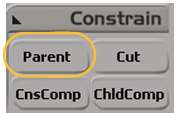When creating a hierarchy, you should first analyze how you want the properties in the hierarchy arranged so that you can parent the objects appropriately. In a hierarchical structure, properties are propagated from a parent to a child.
To cut the links in a hierarchy, see Deleting Objects in a Hierarchy. To reorder the children of a parent, use the schematic view as described in Reordering Child Nodes in the Schematic [Interface and Tools].
To create a hierarchy with the parent first
You can create a hierarchy by having either the proposed children or parent objects selected first, but sometimes it's easier to have the parent object selected first.
